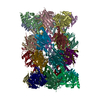+Search query
-Structure paper
| Title | Structure of the reduced microsporidian proteasome bound by PI31-like peptides in dormant spores. |
|---|---|
| Journal, issue, pages | Nat Commun, Vol. 13, Issue 1, Page 6962, Year 2022 |
| Publish date | Nov 15, 2022 |
 Authors Authors | Nathan Jespersen / Kai Ehrenbolger / Rahel R Winiger / Dennis Svedberg / Charles R Vossbrinck / Jonas Barandun /   |
| PubMed Abstract | Proteasomes play an essential role in the life cycle of intracellular pathogens with extracellular stages by ensuring proteostasis in environments with limited resources. In microsporidia, divergent ...Proteasomes play an essential role in the life cycle of intracellular pathogens with extracellular stages by ensuring proteostasis in environments with limited resources. In microsporidia, divergent parasites with extraordinarily streamlined genomes, the proteasome complexity and structure are unknown, which limits our understanding of how these unique pathogens adapt and compact essential eukaryotic complexes. We present cryo-electron microscopy structures of the microsporidian 20S and 26S proteasome isolated from dormant or germinated Vairimorpha necatrix spores. The discovery of PI31-like peptides, known to inhibit proteasome activity, bound simultaneously to all six active sites within the central cavity of the dormant spore proteasome, suggests reduced activity in the environmental stage. In contrast, the absence of the PI31-like peptides and the existence of 26S particles post-germination in the presence of ATP indicates that proteasomes are reactivated in nutrient-rich conditions. Structural and phylogenetic analyses reveal that microsporidian proteasomes have undergone extensive reductive evolution, lost at least two regulatory proteins, and compacted nearly every subunit. The highly derived structure of the microsporidian proteasome, and the minimized version of PI31 presented here, reinforce the feasibility of the development of specific inhibitors and provide insight into the unique evolution and biology of these medically and economically important pathogens. |
 External links External links |  Nat Commun / Nat Commun /  PubMed:36379934 / PubMed:36379934 /  PubMed Central PubMed Central |
| Methods | EM (single particle) |
| Resolution | 2.77 - 8.3 Å |
| Structure data | EMDB-15365, PDB-8adn:  EMDB-15366: Vairimorpha necatrix 26S proteasome from sporoplasms  EMDB-15367: Vairimorpha necatrix 20S proteasome from sporoplasms |
| Source |
|
 Keywords Keywords | HYDROLASE / Peptidase Activity / Reductive Evolution / Bound Peptide / Microsporidia |
 Movie
Movie Controller
Controller Structure viewers
Structure viewers About Yorodumi Papers
About Yorodumi Papers





 vairimorpha necatrix (fungus)
vairimorpha necatrix (fungus)